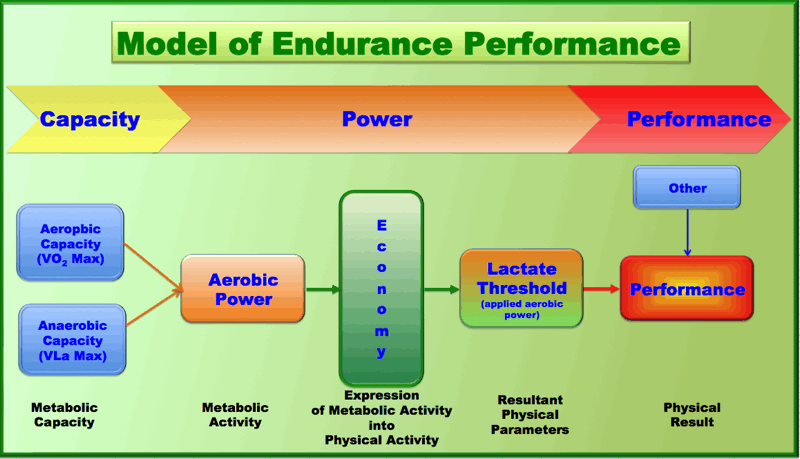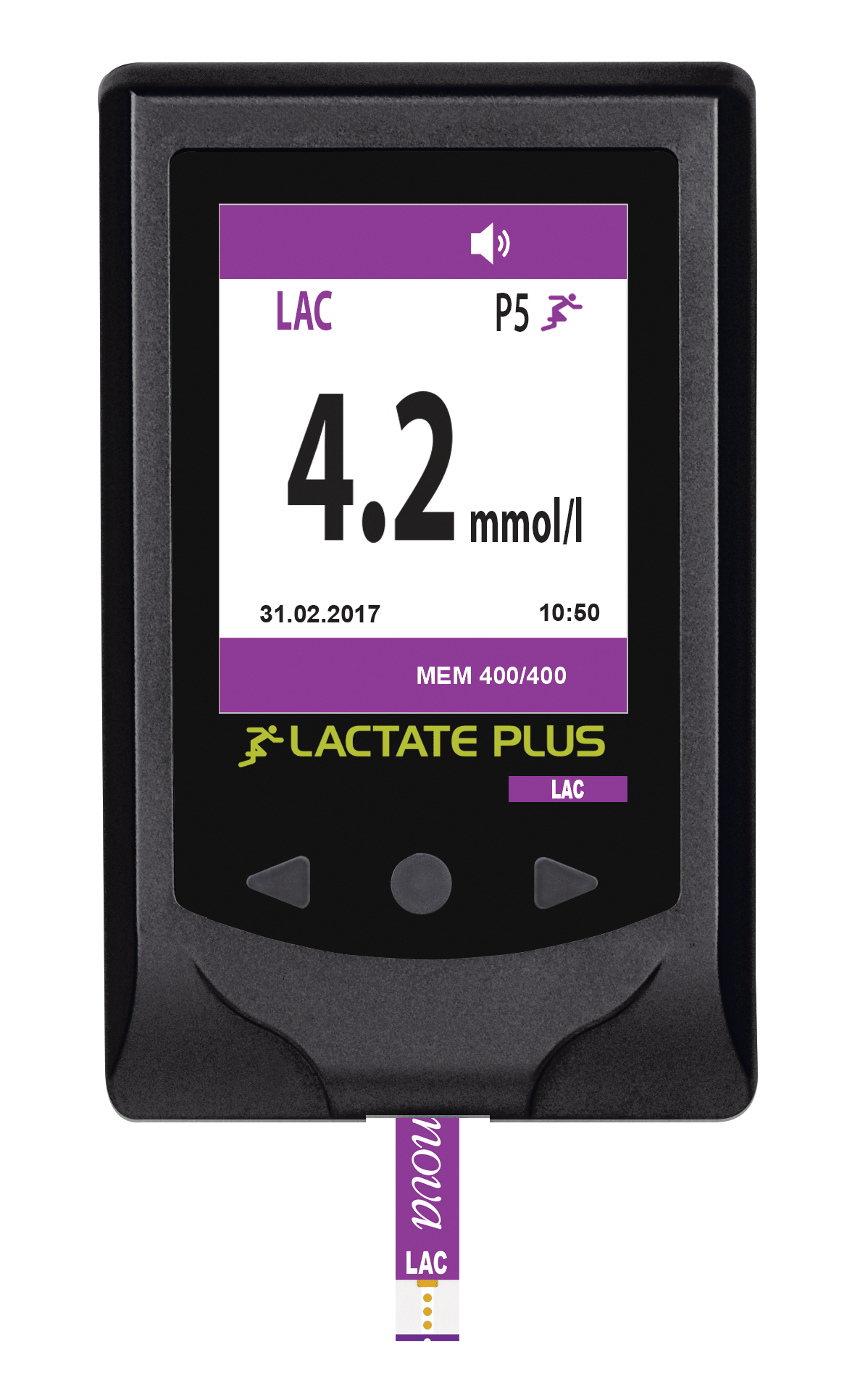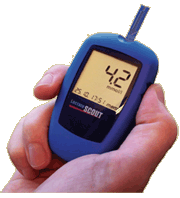Secrets of Lactate Course
Available online - Click for details
Lactate Threshold Discussion - Part 4
(If you entered this page first it is probably best to go to Part 1. The information is meant to be read in order)
Revised Model of Performance - As we have seen both VO2 max and economy affect the lactate threshold (LT) but the LT does not affect the two other variables. Thus, the model of performance presented above needs to be changed. Of the three original factors, the one that most affects endurance performance is the lactate threshold. Athletes and coaches may not think of it this way, but the purpose of most endurance training is to improve performance at the threshold.

A high percentage of the training of an athlete is trying to affect these two factors that drive the lactate threshold. Few question the value of trying to raise ones VO2 max and proper biomechanics is a major emphasis for nearly every training program. But we know of no one who will say that this is all there is to it.
Is There Another Factor?
So there is a problem. Economy and VO2 max do not explain the threshold completely. This has been long understood and most training literature will acknowledge this. But most never discuss just what else affects the threshold, only that the threshold affects performance. Thus, the model is missing an important part of the picture. The above model is a more accurate one than what was originally presented, since VO2 max and economy affect the threshold. But it is missing something. What is it?
What would cause the lactate threshold to change while economy and VO2 max remain the same? What would cause VO2 max and the lactate threshold to go in different directions, which happens sometimes? The answer is quite simple. Look no further than what produces lactate. If the problem occurs because lactate and other metabolites are rising, then what is causing lactate and these other metabolites to rise.
The answer is the anaerobic system , which is rarely considered in exercise physiology and sports training for endurance events. One reason the anaerobic system is rarely considered is because it is very difficult to measure. The other reason it is not considered important is because it provides relatively little energy in an endurance event. However, it can be assessed through lactate testing and sometimes by other means. But it is not as easily measured as VO2 max. The effect of the anaerobic system on the lactate threshold has been in the literature for over 35 years but has essentially been ignored.
Given the above model, it becomes essential for the endurance athlete to measure the lactate threshold periodically, but it also is important to assess all the variables that determine the threshold because if one wants to improve the threshold one has to train those parts of one's physiology that determine it.
A better model of what is happening is in the following chart. This is derived from the work of Alois Mader and Jan Olbrecht. It expands on the model in the previous chart. It also separates what is happening in the body from what the athlete actually encounters in a race. The following model is meant for endurance athletes only such as triathletes, road cyclists, marathoners or cross country skiers. A more general model that includes short events will be presented after the discussion of the endurance athlete. This more general model applies to the Ironman who takes more than 8 hours to finish a race and the 50 m freestyler in swimming who takes about 20-25 seconds to finish the race but the model below is only for distance events.

Before discussing the model in detail, we want to emphasize a couple things. The left side of the model represents what happens within the muscles in terms of energy production. The green box in the middle represents all the factors both within and external to the athlete that translate this energy into effective motion (see discussion of economy above). The right side of model represents the output in the physical environment in terms of performance.
anaerobic capacity - like aerobic capacity it is the ability to generate energy but through the glycolytic system or the breakdown of glucose. We define it as the maximal or organic potential to produce pyruvate or lactate which is the output of the anaerobic glycolytic system. It is where lactate originates in the body.
First, the model isolates the energy produced from the actual activity. Activating a certain set of muscle fibers accesses two types of energy capacities in these muscles, which we indicate by the two boxes of the left. These two boxes represent capacity and not actual realized energy. At rest they are hardly stirred and produce the low energies needed to do things at low activity. But as energy demands increase, such as in a 100 m freestyle race or a marathon, both capacities are accessed and a lot more energy is produced. Depending upon the length of the race or workout, both anaerobic and aerobic energy will be generated but the proportion will be different. Each athlete's energy system as a result of training will be unique. He or she will have a specific aerobic power: the amount of aerobic energy that can be produced and sustained over the period of the event. This is much less than the aerobic capacity of the athlete, but is influenced by BOTH systems.
Notice, at this point we have not said anything about a sport or event. We are talking only energy production. But at some point the energy production must move the muscles at a specific rate and in a specific manner for a specific time in a specific physical environment. Thus we have inserted economy. Economy represents the conversion of the metabolic environment to the physical environment that the muscles are exposed to and how efficiently the energy produced is creating actual motion in the desired direction of the race or athletic event.
The body converts this metabolic energy to mechanical energy at a certain level of efficiency – this is vitally important. However, it’s not the only thing: the economy of movement also includes the actual physical movement of the body during the event and its interaction with the environment and this is also critical.
In a swimming race, there are many factors: stroke mechanics, body and head positions, the type of suit and cap, body density, body hair, temperature of the air and water, pool length, water turbulence, current, and wind. In other words, this aerobic power must interface with the outside physical world to come up with a race time.
Economy is an important factor in a swimming race as it is in any other race or athletic competition.
The lactate threshold test is a key measure that reflects both the effect of metabolic activity and economy of movement that results from interaction with the physical world. The lactate threshold (which represents applied aerobic power) is the single biggest driver of success in endurance events and the main thing you want to emphasize in training for distance events. This test measures aerobic power and through that, aerobic capacity.
Because the main thing driving performance for an endurance athlete is the lactate threshold, not only should it be measured but also what is actually determining the threshold should be measured too. Without these measures the coach or athlete is guessing as to what is happening.
But since anaerobic capacity also affects aerobic power and thus the lactate threshold, the threshold alone is an imperfect measure of aerobic capacity. Thus, a second test is needed for anaerobic capacity. It also will be affected by all the interactions with the outside world that apply to aerobic testing.
We will see that for shorter events, the maximum test (or applied anaerobic power) is even more important because it attempts to measure the speed that will be necessary to win short races, not just the effect it has on the lactate threshold. In endurance races the anaerobic capacity might make a difference if the race comes down to a sprint at the end but its real importance is in how it acts as a gatekeeper for the amount of aerobic energy that can be utilized. The athlete with the bigger anaerobic capacity will normally win that sprint. But otherwise it is the lactate threshold that wins the race and often a LOWER anaerobic capacity causes the lactate threshold to improve
The above model includes three factors not in the original model: Anaerobic Capacity, Aerobic Power, and something called "Other". "Other" is things like psychological training, hydration, electrolyte replacement, hyperthermia, nutrition, injury etc. Some of these are extremely important. Things such as wind and current in a distance swimming race, heat and hills in a cycling race or marathon affect things in a major way but this is included under the economy factor, as we are defining economy as everything that affects implementation of aerobic power.
Anaerobic Capacity - This is one of the two main factors underlying performance. It is difficult to measure, and that is probably why it is not part of many assessments of training efficiency. But it still has an effect and cannot safely be ignored because it is difficult to measure.
Most coaches and sports scientists think that anaerobic capacity affects only short events. But there is substantial evidence that high anaerobic capacity can dramatically depress performance in endurance events. At various places in this course this mechanism is discussed in detail. Many have said that no one understands the lactate threshold (because it doesn’t always correlate with other measures of aerobic capacity such as VO2 max). Actually, once anaerobic capacity is taken into account, it all makes sense. There are research papers as early as 1986 that talk about the effect of too much anaerobic capacity, but this has largely been ignored in coaching practice and in academic research.
Let's return to the four cyclists from the beginning of this discussion.
| Cyclist | VO2 Max | Anaerobic Capacity | Lactate Threshold |
|---|---|---|---|
| ml/kg/min | mmol/l/s | watts | |
| A | 76.1 | .317 | 406 |
| B | 67.5 | .313 | 362 |
| C | 70.8 | .790 | 315 |
| D | 61.4 | .770 | 257 |


